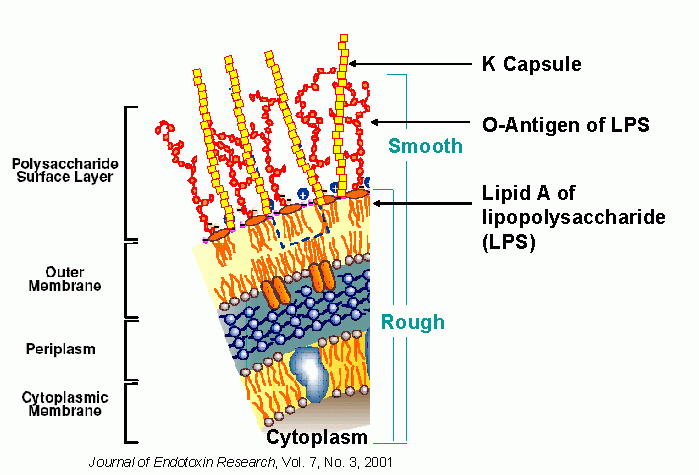BerkiGEM2007Present4
From 2007.igem.org
The Chassis
Introduction There are several core issues associated with introducing E. coli into the bloodstream of human beings or other animals. First is the issue of sepsis. E. coli possesses a species called lipid X, or endotoxin, in its outer membrane which causes the release of TNFalpha in humans. This is an essential process of the innate immune system, but with high doses of lipid X, can be lethal. Bactoblood must have some ability to avoid this series of events. Similarly, there are a variety of additional features in E. coli that can elicit strong adaptive immune responses including the pili and flagella. From the bacterium's perspective, the interaction with the bloodstream is no more desirable. The complement system, another core component of the innate immune response, can kill bacteria directly. Additionally, phagocytic cells including macrophages and neutrophils, can engulf and kill E. coli. Fortunately for our purposes, there are a variety of modifications we can make to circumvent these problems.
The E. coli outer surface
To understand these modifications, we must first understand what features are present in E. coli strain MC1061, our starting point for the Bactoblood. Like most strains of E. coli used in the lab, MC1061 comes from the MG1655 lineage and is a "rough" strain. Unlike other "smooth" strain, MC1061 lacks surface-displayed capsular polysaccharides known as K capsules and O antigens. It retains the general 2-membrane architecture present in gram-negative bacteria. The inner membrane is composed of a lipid bilayer and a wide variety of proteins. The outer membrane similarly is a lipid bilayer, and the lipid component of it is called lipopolysaccharide, or LPS. The structure of LPS is fairly diverse, but at it's core is a 6 fatty acid lipid called lipid X. When O antigens are present, they are covalently attached to the outer leaf of LPS. K capsules are simmilarly embedded in the outer leaf of the outer membrane, but they are not directly attached to LPS. Other components of the outer membrane include a structural protein, LPP, and a variety of other proteins. This outer surface is the critical region of the bacterium for understanding how it interacts physically from the outside world. When the bloodstream "looks" at E. coli, what it "sees" is the outer membrane because everything else is stuck inside. Modifications such as O-antigens and K-capsules therefore have dramatic effects on the bacterium's interactions with the outside world. In between the inner and outer membranes is the periplasmic space which is composed of a gel-like carbohydrate-rich polymer called peptidoglycan.
K capsules and O-antigens capsular polysaccharides
The carbohydrates embedded in the outer membrane are extremely diverse within the E. coli species. Both are linear polymers of carbohydrates and sometimes amino acids, but at least 150 chemically-distinct O-antigens exist in one E. coli strain or another. Similarly, at least 100 chemically-distinct K capsules have been described. Almost all pathogenic strains of E. coli have some sort of capsular polysaccharide and are therefore referred to as "smooth" strains. The rough vs. smooth distinction refers to a visibly discernible quality of their colonies. The particular choice of carbohydrate present in a bacterium is essential to its ability to survive in its living environment. For pathogenic and commensal bacteria, specific O or K carbohydrates are appropriate for distinct areas of the body (blood stream, urinary tract, intestines) and also for distinct animal types (birds, pigs, humans, cows, etc.). Over 90% of human cases of E. coli bacteremia (the clinical word for having bacteria in the bloodstream) are caused by strains that have a specific type of K capsule called K1. K1 is a long linear polymer of sialic acid that extends about half the diameter of the bacterium beyond its surface. Because polysialic acid is a frequent coating on mammalian cells, the human immune system does not recognize K1 as foreign. Bacteria with a K1 capsule are therefore resistant to both innate and adaptive immune responses. Proper display of a K1 capsule requires the concommitant expression of any of several O antigens. For our studies, we have chosen O16. Genetically, the K1 capsule requires ## genes encoded within a ##kb cassette. The O16 antigen requires ## genes encoded within a ##kb cassette. Together, these surface modifications allow the bacterium to avoid detection by the immune system and are predicted to extend the serum half-life of Bactoblood to several hours rather than the less-than-5 minutes observed with rough strains.
Lipid X and its variants
Growth control by iron restriction
White blood cells constantly roam the bloodstream in search of foreign bodies. The human immune system targets potentially infectious bacteria by membrane signature and the presence of antigens (PLEASE ADD CLEAR INFO HERE CHRIS, LIKE THE VERY FIRST INTRO POWERPOINT YOU SHOWED US). Some bacteria, however, are able to evade detection. Our bacteria mimics these characteristics.
